Howard Gardner And Multi-intelligence Theory
For decades, people thought that intelligence was the only function of the mind that defined our ability to solve problems, especially in the logical-mathematical realm. But about three decades ago, Howard Gardner questioned this idea. He proposed a theory of several types of intelligence instead of one global intelligence.
Basically, Gardner realized that people did not have a single intelligence that applied to every aspect of life. In fact, intelligence was different, and he called them many kinds of intelligence. The latest theories of psychology regarding intelligence have thus left behind that traditional and perhaps even unfair concept of intelligence.
As we said, it is not long since only the logical-mathematical and linguistic part of intelligence was measured and developed. But multi-intelligence theory sees cognitive abilities as a group of skills and psychic abilities called “intelligences”. In addition, everyone has these skills and mental abilities to some degree.
The definition of intelligence according to Gardner
Academic superiority is not everything
Gardner defines intelligence as “the ability to solve problems or create products that are valued in one or more cultures.” First, he broadens the definition of intelligence and acknowledges what people have always known intuitively, namely that some intelligences are related to school success, while others, equally important, are not. At least not directly or in the way intelligence has traditionally been measured.
In fact, the academic factor is usually not the best predictor of how far a person will go in their life. Some people get very high scores on traditional IQ tests, but they don’t have the slightest interpersonal skills, for example.
Succeeding in business or sports requires intelligence, but every aspect needs different intelligence, no better or worse, just different. In other words, Einstein is no more or less intelligent than Michael Jordan; his intelligence only suits different areas.
In fact, what the theory of multi-intelligence defends is that we adapt our teaching methods to the different intelligences of each person. This would even reduce the cost of training (time, resources, energy).
Intelligence is a skill that can be developed
Second, and this is just as important, Gardner defines intelligence as a skill. Until some time ago, people saw intelligence as innate and unchanging. So man was either born intelligent or not, and education could not change it in any way. As a result of this thinking, mentally handicapped people were not educated because it was seen as useless.
Defining intelligence as a skill means that it is an ability that can be developed. Gardner does not deny the genetic component, but believes that these “potentials” develop depending on a person’s environment, experience, education, and so on.
No top athlete can reach the top without training, no matter how talented he is inherently. The same could be said of mathematicians, poets, or emotionally intelligent people. Thus, according to the multi-intelligence model proposed by Howard Gardner, we all have the opportunity to develop our intelligence, abilities, and motivation with support.

Multi-intelligence theory: 8 different types of intelligence
Logical-mathematical intelligence
Gardner defines this intelligence as the ability to understand abstract relationships. We use it to solve logical and mathematical problems. It corresponds to the way of thinking of the logical hemisphere and to what our culture has always seen as the only kind of intelligence (Morchio, 2004: 4).
According to Gardner (1999a), this intelligence covers:
- the ability to handle numbers efficiently
- analyze problems logically
- study problems scientifically
Such people enjoy:
- solving mysteries
- playing with numbers and complex calculations
- calculation
- organizing the information into tables
- repairing computers
- making peanuts
- playing video games
They are also able to evaluate, perceive, and remember numbers and statistics well (Armstrong, 2003). This is the intelligence of mathematicians, scientists, engineers, and logicians (Gardner, 1999a).
Linguistic intelligence
This is the most valued form of intelligence in learning and teaching foreign languages, as it involves reading, writing, listening, and speaking (Morchio, 2004). This intelligence implies a particular sensitivity to spoken and written language. It includes ability in syntax, phonetics, semantics, and pragmatics (rhetorical, memory engineering, explanation, and metalanguage) (Morchio, 2004: 4).
Linguistically intelligent people seem extremely natural when explaining things, teaching or persuading people, as they use language very accurately. According to Armstrong (2003), they like to spend time:
- from
- telling stories or jokes
- watching movies
- writing a diary
- making art
- writing poems
- learning foreign languages
- playing word games
- examining
Lawyers, writers, poets, teachers, comedians, and speakers have this intelligence (Gardner, 1999a).
Musical intelligence
This intelligence includes “the ability to perceive forms of music” (Guzmán & Castro, 2005: 185). It signifies the ability to compose, interpret, modify, and evaluate all kinds of music and sounds (Gardner, 1999a).

These people have “sensitivity to rhythm, cadence, tones and chords, and to the sounds of nature and the environment” (Guzmán & Castro, 2005: 185). According to Armstrong (2003), such people like to spend a lot of time:
- singing
- listening to music
- playing instruments
- attending concerts
- creating music
- humming while studying
In summary, music lovers have this intelligence: composers, singers, sound technicians, musicians, music teachers, etc. (Guzmán & Castro, 2005).
Spatial and visual intelligence
Spatial and visual intelligence encompasses the ability to edit and perceive 2D and 3D images in one’s mind (Armstrong, 2000a). It is also the ability to understand, process, and modify the composition of both large and small spaces (Gardner, 1999a).
It is easy for people with the highest intelligence to be spatial and visual to remember photographs and objects rather than words. They notice cars, bikes, clothing, and hair (Armstrong, 2003).
Such people like to spend time:
- drawing
- hanging
- painting
- playing video games
- making designs
- including maps
- studying optical illusions and labyrinths
Such is the intelligence of architects, pilots, sailors, chess players, surgeons and artists. Painters, graphic designers, and sculptors also have this intelligence (Gardner, 1999a).
Kinesthetic-exercise intelligence
Kinesthetic-intellectual intelligence consists of the ability to use the body (the whole body or only parts of it) to express ideas, learn, solve problems, perform tasks, or create products (Gardner, 1999; Morchio, 2004). Such people learn physical skills easily and quickly. They love to exercise and play sports. In other words, their favorite things at school are breaks or exercise (Armstrong, 2003). They know how to dance beautifully, act and imitate other people’s expressions and manners (Armstrong, 2003). Such people think while moving and learn better while on the move (Armstrong, 2003).
Such intelligence is usually very much present in athletes, ballerinas, actors, surgeons, artisans, inventors, mechanics, and other technical professionals (Gardner, 1999).

Interpersonal intelligence
Interpersonal intelligence includes the ability to focus on things that are important to other people. It means remembering others ’interests, motivations, worldview, personal story and intentions. This often includes the ability to anticipate people’s decisions, feelings, and actions (Armstrong, 2003; Gardner, 1993a; 2006).
People with a naturally high level of interpersonal intelligence like to talk, learn in groups or in pairs, and do work or other things with people (Armstrong, 2003). They spend a lot of time helping people and enrolling in important volunteering activities (Armstrong, 2003). In addition, they are “good mediators in situations of conflict”. (Guzmán & Castro, 2005: 187).
They are good communicators as they use both verbal language and body language. They have a lot of friends, they feel genuine compassion for others, and they know how to motivate others (Armstrong, 2003). This intelligence is shared by teachers, therapists, counselors, politicians, salespeople, and religious leaders (Gardner, 2006).
Ability to understand nature
The ability to understand nature is defined as the sensitivity to naturally occurring forms and geological features of the earth. It includes the ability to distinguish and classify details and elements of an urban, suburban, or rural environment (Morchio, 2004). According to Armstrong (2003), such people enjoy:
- hiking
- hiking
- pet care
- learning and classifying the names of people, animals, plants, and objects around them
This type of intelligence is most important in those cultures that depend on hunting, fishing, and gathering. Natural and social scientists, poets and artists have this intelligence. They are generally able to extract details and utilize and develop their perceptual abilities in their work (Gardner, 1999a).

Existential intelligence
You may have existential intelligence or “big question” intelligence. But Gardner (2016) has not confirmed whether it is real intelligence or not. Although it meets almost all the criteria, it lacks one. There is no evidence that any particular part of the brain deals with philosophical, existentialist issues.
A key part of this intelligence is the tendency to think of things as questions and to look for answers that go beyond the experience of perception. People like this think things like this: Why is there life? Why is there death? Why are wars going on? What will happen in the future? What is love? (Gardner, 2006).
Spiritual intelligence is also part of existential intelligence. While not considered to be intelligence per se, very spiritual people interested in religious matters actually inspired Gardner to explore existential intelligence.
It is a fact that some people are more adept at meditation. These people usually have more spiritual and spiritual experiences (Gardner, 1999a).
Finally: Gardner’s theory of polygamy was a complete revolution. It expands the range of people we can call intelligent. It thus opens a fascinating path that invites us to reflect on something new, that everyone has their own unique “opportunities” and that everyone can be successful if they recognize and develop them.
Multi-intelligence theory sees people positively. In the end, it seems much more realistic than the traditional, one-sided concept of intelligence.
Sources
Gardner, H. (1995). Frames of Mind: The Theory of Multiple Intelligences. Fontana Press.
Lazear, D. (1991a). Seven ways of knowing: Teaching for multiple intelligences (2a ed.). Palatine, IL: Skylight Publishing.








